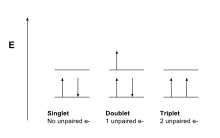Doublet state
In quantum mechanics, a doublet is a mixed quantum state of a system with a spin of 1/2, such that there are two allowed values of the spin component, −1/2 and +1/2. Quantum systems with two possible states are sometimes called two-level systems. Essentially all occurrences of doublets in nature arise from rotational symmetry; spin 1/2 is associated with the fundamental representation of the Lie group SU(2), the group that defines rotational symmetry in three-dimensional space.
History and applications
The term "doublet" dates back to the 19th century, when it was observed that certain spectral lines of an ionized, excited gas would split into two under the influence of a strong magnetic field, in an effect known as the anomalous Zeeman effect. Such spectral lines were observed not only in the laboratory, but also in astronomical spectroscopy observations, allowing astronomers to deduce the existence of, and measure the strength of magnetic fields around the sun, stars and galaxies. Conversely, it was the observation of doublets in spectroscopy that allowed physicists to deduce that the electron had a spin, and that furthermore, the magnitude of the spin had to be 1/2. See the history section of the article on spin (physics) for greater detail.
Doublets continue to play an important role in physics. For example, the healthcare technology of magnetic resonance imaging is based on nuclear magnetic resonance. In this technology, a spectroscopic doublet occurs in a spin-1/2 atomic nucleus, whose doublet splitting is in the radio-frequency range. By applying both a magnetic field and carefully tuning a radio-frequency transmitter, the nuclear spins will flip and re-emit radiation, in an effect known as the Rabi cycle. The strength and frequency of the emitted radio waves allows the concentration of such nuclei to be measured.
References
IUPAC. Compendium of Chemical Terminology, 2nd ed. (the "Gold Book"). Compiled by A. D. McNaught and A. Wilkinson. Blackwell Scientific Publications, Oxford (1997). XML on-line corrected version: (2006-) created by M. Nic, J. Jirat, B. Kosata; updates compiled by A. Jenkins. ISBN 0-9678550-9-8. doi:10.1351/goldbook
